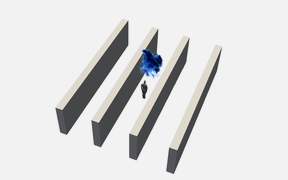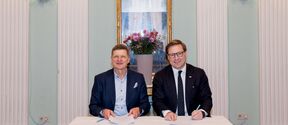Modelling confirms: Isolating the ill and prioritising remote work are key strategies in combating the coronavirus
In March of this year, Aalto University, the Finnish Meteorological Institute, VTT Technical Research Centre of Finland and the University of Helsinki launched a joint project aimed at investigating airborne transmission and spread of coronavirus in indoor spaces.
When a person speaks, cough or sneezes, droplets are generated from their respiratory tract, and these can carry pathogens such as coronaviruses.
Researchers have now published the first, preprint version of the paper, which has been submitted for peer-review and published already at Arxiv.org. The paper details how they have modelled the airborne transport of different-sized droplets. These are emitted through coughing, so the study evaluated the quantities of particles that someone could come into contact with upon entering a supermarket or any other indoor public space.
Assistant professor at Aalto University, and project coordinator, Ville Vuorinen, says that both previous related research, and a number of well-known infection spikes, indicate a substantial risk of coronavirus through inhalation of aerosol particles, as well as direct droplet transmission and transmission from surfaces. The 3D flow simulations and analyses carried out in the project also support these ideas.
‘Our simulations show that virtually all droplets of less than 50 micrometres – and thus the majority of those produced when coughing – dry up as particles before they reach the floor and then linger around as carried by the indoor airflows. We consider it possible that these particles contain enough virus pathogens to cause infection’, says Vuorinen.
Docent Antti Hellsten, from the Finnish Meteorological Institute, says ‘We modelled a typical indoor space, separated with shelves and room dividers, with high-resolution 3D flow simulations. In the modeling, the coughing of a person carrying the coronavirus raised the particle content in the immediate environment to such a high level that risk for exposure was still considered to be significant about four metres away. The risk remained significant for up to several minutes afterwards’.
Although the risk of infection during a single shopping trip is relatively low, Vuorinen emphasises that at the probability of infection accumulates with regular exposure throughout several weeks.
‘Tens of millions of grocery trips are carried out in Finland each month, and the likelihood of exposure in a grocery store could be as high as 1/1000 during particular stages of the pandemic. This would mean that as many as 10 000 Finns are exposed each month. If infectious people with symptoms stay at home and people reduce their excursions to public places, the risk decreases significantly’, Vuorinen explains.
Even talking can be enough to transmit the virus
For the paper, the researchers examined well-known infection spikes in which a large number of people are believed to have been infected by a single pre-symptomatic infectious person. Based on other similar cases and previous studies, the researchers estimated that participants could have inhaled 50-500 aerosol particles which could have been enough for significant exposure.
‘In the modeling, we examined the effect of the length of time spent in the space, the total number of people and the number of those coughing. One person per square metre, as is common in bars, just simply talking, can create a particle cloud sufficient for infecting others nearby. A symptomatic person working in an open office can create concentrations in the surrounding space ranging, on average, from 10 to 500 aerosol particles per cubic metre. If 100 aerosol particles per cubic metre are taken as the risk limit for exposure, people may therefore have exposure in times ranging from a few minutes to as long as several hours’, Vuorinen adds.
According to the researchers, it is likely that infection spikes always involve direct contact infection, aerosol infection and shared surface infections. The longer you are there, and the closer the proximity to others, the greater the risk of infection.
Isolation measures have gradually started to be relaxed in Finland and many other countries, but researchers still recommend doing work remotely as much as possible. That being said, the safety of workplaces could be improved in many ways.
‘The most important thing is that nobody comes to work sick. There should be the appropriate ventilation, sufficient space between workers and with only the minimum amount of personnel necessary. This reduces both people’s proximity to each other and possible exposure time’, Vuorinen explains.
Supercomputer used for modelling tasks
The project involves around 30 researchers whose specialisations include flow dynamics, aerosol physics, social networks, ventilation, biomedical engineering, health sciences and medicine.
The airborne movement and preservation of droplets leaving the respiratory tract were calculated using the supercomputer owned by CSC – IT Center for Science Ltd, and various analyses and 3D visualisations of the results were carried out.
‘The physics of the phenomena now modelled are already reasonably well known, but this new research sheds new light on them, particularly from the perspective of the coronavirus and public spaces,’ says Ville Vuorinen.
‘Our understanding of the airborne transmission of SARS-CoV-2 virus has changed significantly in recent months,’ says Assistant Professor Tarja Sironen from University of Helsinki.
CSC is prioritising the provision of computing capacity and expert assistance for research aimed at combating the COVID-19 pandemic. If you are working directly on a pandemic-related research project, please contact servicedesk@csc.fi.
More information
Assistant Professor Ville Vuorinen
Aalto University
tel. +358 (0)50 361 1471
ville.vuorinen@aalto.fi
Docent Antti Hellsten
Finnish Meteorological Institute
tel. +358 (0)29 539 5566
antti.hellsten@fmi.fi
Senior Researcher Aku Karvinen
VTT Technical Research Centre of Finland
tel. +358 (0)40 510 2142
aku.karvinen@vtt.fi
Assistant Professor Tarja Sironen
University of Helsinki
tel. +358 (0)50 447 1588
tarja.sironen@helsinki.fi
Peter Råback
CSC – Finnish IT Сentre for Science Ltd
tel. +358 (0)9 457 2080
peter.råback@csc.fi
Researchers modelling the spread of the coronavirus emphasise the importance of avoiding busy indoor spaces
A joint project carried out by four Finnish research organisations has studied the transport and spread of coronavirus through the air. Preliminary results indicate that aerosol particles carrying the virus can remain in the air longer than was originally thought, so it is important to avoid busy public indoor spaces. This also reduces the risk of droplet infection, which remains the main path of transmission for coronavirus.

Read more news

The semiconductor sector jobs open in research groups
Semi-Summer 2026 programme will provide an opportunity to gain the skills needed in a growing and international semiconductor sector.
New cooperation agreement between the City of Helsinki and Aalto University to strengthen a sustainable, vibrant and knowledgeable city
The main themes of the cooperation are vitality, innovations and entrepreneurship, as well as research cooperation and knowledgeable labour, drawing heavily on the research and education expertise of the university.
Aalto Inventors innovation training coming for hydrogen, quantum and microelectronics researchers this spring
Connect with industry and academic thought-leaders and gain widely applicable skills in communication, intellectual property, and business.






